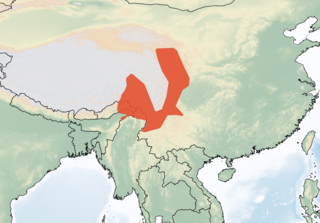
The yellow-necked mouse, also called yellow-necked field mouse, yellow-necked wood mouse, and South China field mouse, is closely related to the wood mouse, with which it was long confused. It was only recognised as a separate species in 1894. It differs in its band of yellow fur around the neck and in having slightly larger ears and usually being slightly larger overall. Around 100 mm in length, it can climb trees and sometimes overwinters in houses. It is found mostly in mountainous areas of southern Europe, but extends north into parts of Scandinavia and Britain. It facilitates the spread of tick-borne encephalitis to humans and is a reservoir species for the Dobrava virus, a hantavirus that is responsible for causing haemorrhagic fever with renal syndrome.

Apodemus is a genus of murid containing the field mice as well as other well-known species like the wood mouse and the yellow-necked mouse. The name is unrelated to that of the Mus genus, instead being derived from the Greek ἀπό-δημος.

The striped field mouse is a rodent in the family Muridae. The range of this species stretches from Eastern Europe to Eastern Asia.

The Korean field mouse, also known as the Korean wood mouse, is a species of mouse. It is distributed across Northeastern Asia, including the Russian Far East, northern China, the Korean Peninsula, Sakhalin, and Hokkaidō. It is not found on the Korean island of Jeju. The adult has a body length of 76–125 mm, with a tail of nearly equal length (75–112 mm).

The alpine field mouse is a species of rodent in the family Muridae. It is found in Austria, France, Italy, Germany and Switzerland.

The small Japanese field mouse is a species of rodent in the family Muridae. It is endemic to Japan, spanning from Hokkaido to Kyushu and is similar to its larger counterpart, Apodemus speciosus.
Chevrier's field mouse is a species of rodent in the family Muridae. It is found only in China.
The Himalayan field mouse is a rodent in the family Muridae. It is endemic to Nepal.

The steppe field mouse is a species of rodent in the family Muridae found in Georgia, Armenia, Azerbaijan, Israel, Palestine, Turkey, Jordan, Iran, Turkmenistan, Lebanon, Syria, the Greek island of Rhodes, Ukraine and possibly Afghanistan and Iraq,. The Mount Hermon field mouse and the yellow-breasted field mouse were considered conspecific with the steppe field mouse by Musser and Carleton (2005).
The Caucasus field mouse is a species of rodent in the family Muridae.

The Sichuan field mouse is a species of rodent in the family Muridae. It is found in Qinghai and Sichuan provinces of China, and in India and Burma.

The eastern broad-toothed field mouse is a species of rodent in the family Muridae.
The Black Sea field mouse is a species of rodent in the family Muridae. It is found in Armenia, Azerbaijan, Georgia, possibly Iran, Iraq, Russian Federation, and Turkey.
The Kashmir field mouse is a species of rodent in the family Muridae. It is found in India, Nepal, and Pakistan.

The Taiwan field mouse, also called Formosan wood mouse, is a species of rodent in the family Muridae. It is found only in Taiwan.

The large Japanese field mouse is a nocturnal species of rodent in the family Muridae. It is endemic to Japan.

Ward's field mouse is a species of rodent in the family Muridae. It is found in Kyrgyzstan, Tajikistan, Afghanistan, India, Iran, Nepal, and Pakistan.














